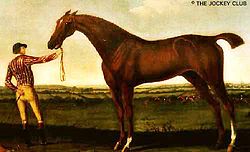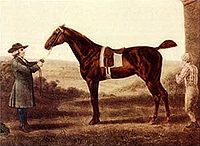- Diomed
-
- For other meanings see Diomede (disambiguation) and Diomedes (disambiguation).
Diomed, foaled in 1777, was an English-bred Thoroughbred race horse who won the inaugural running of the Epsom Derby and was subsequently a successful sire in the United States of America.
Diomed 
Diomed "the Marvel"Sire Florizel Grandsire Herod Dam Mare (1763) by Spectator Damsire Spectator Sex Stallion Foaled 1777 Country Great Britain Colour Chestnut Breeder Honorable Richard Vernon of Newmarket Owner Sir Charles Bunbury, 6th Baronet Record 20: 11-5-3 Honours Diomed Stakes Epsom Downs Racecourse Horse (Equus ferus caballus) Last updated on August 24, 2007 Contents
Bright Beginnings
A bright chestnut standing 15 hands 3 inches[1] he was named after the Ancient Greek hero Diomedes, he was by the unraced Florizel out of the unraced Pastorella's Dam, aka Sister to Juno (both going back to the Godolphin Arabian, and Sister to Juno going back as well to Darley Arabian), Diomed was bred by the Hon. Richard Vernon and owned by Sir Charles Bunbury.[1] He was started 19 times, winning 11, placing in 4, and showing in 3. This means he was out of the money only once if things then were as they are now.
Of these eleven wins, ten were consecutive, which included the inaugural running of the Epsom Derby in 1780. During these early bright years of Diomed's life, he was considered by many to be the best colt seen in Britain since the great English Eclipse, known as the Thoroughbred Eclipse.
He was allowed to rest for a while, but when he was brought back to the races, he wasn't the same horse. Sometimes he would win, and sometimes he wouldn't win, and more often the latter than the former. His last win was a King's Plate in four mile heats carrying 168 pounds.
Long dull years
Sir Charles retired Diomed to stud. His fee was five guineas, or about $25. (In England Diomed sired Grey Diomed who went to Russia where he was a great success, and also Young Giantess, who foaled Sorcerer and Eleanor.[1]) There were few takers, and for the next decade or so, Diomed's fee went down and down until, by the age of 21, it was two guineas. By then, there were virtually no takers, so the old stallion did nothing but graze alone.[2]
The New World
At what seemed an advanced age, an age when stallions usually retire, Sir Charles offered to sell the 21 year old Diomed. An American called Colonel John Hoomes of Bowling Green, Virginia bought him for $250, and then shipped him to Virginia where he was returned to stud in 1798. Aside from importing bloodstock into the US, Hoomes also maintained his own racing stable and sizeable stud service in which his good friend, another influential horseman of the time, John Tayloe III, was a partner. Although Hoomes and Tayloe's English agent wrote Hoomes a letter stating very clearly that Diomed was "...a tried and true bad foal-getter," and strongly recommending he not be put to stud, they were unswayed. Besides being personally impressed with the horse, a stallion of Tayloe's had also recently hurt himself, and Tayloe was in immediate need of a stud to replace him. Diomed went to work.[2]
In those days, stallions did not stand in one place, but moved from stud farm to stud farm. Diomed lived like this until he was thirty-one years old and was active to his very last days. His fee increased with his fame and his fame increased so quickly that Hoomes was able to sell a share in him for six times his purchase price soon after he set all four hooves on American soil.[2]
Brilliant endings
Diomed, along with Medley, Shark, and Messenger, were the four most important stallions introduced into early American bloodstock. Diomed threw many of the greatest horses in American turf history: Haynie's Maria, who beat every horse she met until she was nine, and about whom Andrew Jackson said, "...Haynie's Maria can beat anything in God's whole creation,"[2] the undefeated Ball's Florizel famous for his bad temper), Potomac, Duroc (sire of American Eclipse), and surely his greatest son of all, Sir Archy. Sir Archy had a huge influence on Thoroughbred history, siring the line which led to Timoleon, Boston, and Lexington.
Diomed's get included saddlehorses for Thomas Jefferson and statesman and jurist John Marshall.
At Diomed's passing at the age of 31, it was reported, "...there was as much mourning over his demise as there was at the death of George Washington."[2]
References
Categories:- 1777 racehorse births
- 1808 racehorse deaths
- Thoroughbred racehorses
- Racehorses trained in the United Kingdom
- Racehorses bred in the United Kingdom
- United States Champion Thoroughbred Sires
- Epsom Derby winners
- British Classic Race winners
Wikimedia Foundation. 2010.

